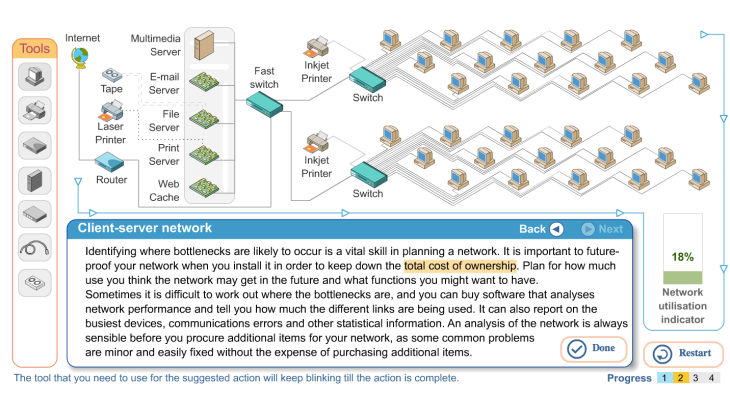Components of a Computing System
Hardware is physical and concrete objects. [Macbook Air& Disks]
Software is program that operate by computers. [iMovie & Photoshop]
Peripheral device is any auxiliary device that communicate and work with computers. [Mouse, Keyboard, Printers]
Human Resources are people who operate computers. [Video editors & Programmers]
Computer Network
Computer Network is a collection of computing devices connected in order to communicate and share resources. Computer network is similar with a body nervous system, physical cables and wireless waves and signals are acting like”blood vessels” which transfer data and signals among computing devices. In terms of computing devices, they are:
Computer network is similar with body nervous system.
Router is the “brain” of network. Routes are very smart and have small little computers inside. A router’s job is to identify all computing devices and assign specific IP Address to each device. The router also connects to the internet out side your home via a modem. Routers manage info that your computer send and receive and control which computer and device get what info and when.
Switch is the “spine”. It sends data/signals to clients by using wires or radio signals. There porks on switches and the speed of different types of switches varies. Gigabit switches are the fastest. Hub is replaced by switch.
Clients are nervous terminals.
Servers provided services that clients requested. For example, email servers manages the flow of email in and out of the network.
Firewall controls data flow among network entities. (Netgear)
Virtual Network
 (use http://www.teach-ict.com/gcse_new/networks/hardware/resources/NWB_SIM.swf created)
(use http://www.teach-ict.com/gcse_new/networks/hardware/resources/NWB_SIM.swf created)
Domain Name Systems (DNS)
People cannot remember the IP address like “74.125.29.101” so we use words like “www.google.com” to represents the IP address. Whenever we type http://www.google.com in browser, the domain name system will process to translate the domain name into its IP address which the computer can understand. Then the computer can access data in that IP address and send the data back to our computer for us view the website. The detailed process is the following:
I typed www.google.com(a domain name) on safari.
The computer go to find whether the IP address of http://www.google.com has already stored in cache memory/database.
If yes, I can directly access to the IP address and the process finished.
If no, the search for IP address starts.
Search for .com in DNS server
Get the IP address for .com in the form of numbers
Search for google.com in DNS server
Get the IP address for google.com in number form
Search for www.google.com in DNS
Get the full IP address and IP address is identified
Connected the IP address to the web server. Then data is downloaded from http://www.google.com, and the IP address is save in cache memory/network server. (“DCN Client Server Model”)
Youtube Video “How the DNS works”
Topology
Topologies are ways how computer connected to each other. There are basically three types.
Ring topology has all input devices connected in a ring. But if one computer goes down, the process can not pursue.
Star topology has all input devices connected at a switch/hub in the center. But if one computer goes down, the process can not be pursued.
Bus topology has computers all connected to one single communication line. If one computer goes down, others will not be affected. Yeah!
Types of Network
(Wireless) Local Area Network (WLAN/LAN)
LAN connects a small number of devices in a close geographical area via wireless radio waves. For example, BNDS Wifi.
Virtual Local Area Network (VLAN)
VLAN is an implementation of a private subset of a LAN in which the computers interact with each other as if they are geographically close to each other irrespective of their actual physical locations.
(Wireless) Personal Area Network (WPAN/PAN)
(W)PAN connects devices in a very small area. For example, the connection between computers, mobile phones, and headphones are WPAN. OS system use a specific type of WPAN called ad-hoc for bluetooth and airdrop.
Wide Area Network (WAN)
WAN connects devices over a large geographic distance. For example, national and international retailers are connected via WAN.
Internet
Internet is a massive network of networks. Internet connects millions of computers together globally, forming a network in which any computer can communicate with each other computer as long as they are connected to the Internet. Metropolitan-area network (MAN) is a network infrastructure developed over a large city.
World Wide Web (Web)
Web is not same as Internet. The Web is just one of the ways to access information over the medium of the Internet.
Intranet
Intranet is a private network within an organization to transmit information securely. Intranets are hardly connected to any other networks. There is firewall to block the information in and out from intranet. For example, the internet email system for a government agency.
Extranet
Extranet is like an intranet which can partially access to the outside internet and exchange information across the internet in very secure ways.
Peer-to-Peer Model (P2P)
P2P is an approach that shares information and responsibilities among many “peer” computers. In a P2P network, if one peer computer wants to find a file, the computer will not only search the file in this computer but all “peer” computers within this P2P network. Information security is difficult to administrate in this case.
Works Cited
“Introduction To Networking”. Webclasses.net. N.p., 2016. Web. 19 Oct. 2016.
Netgear,. How Computer Networks Connect And Work. 2013. Print.
“DCN Client Server Model”. http://www.tutorialspoint.com. N.p., 2016. Web. 19 Oct. 2016.



 (Tutorial)
(Tutorial)